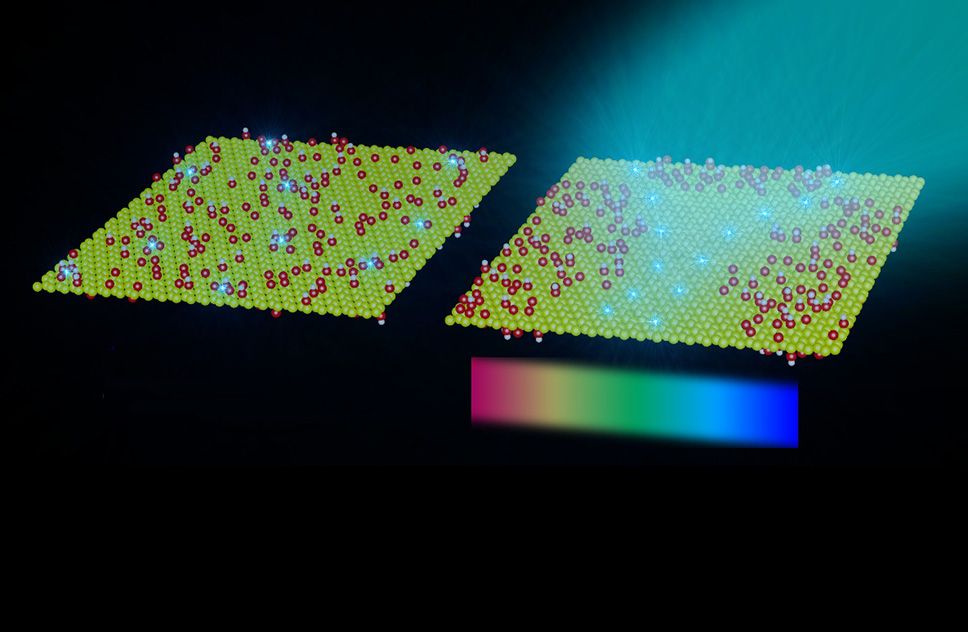New graphene treatment could unleash new uses in electronic devices
MIT team develops simple, inexpensive method that could help
realize graphene’s promise for electronics, solar power, and sensors.
December 17, 2013

Comparison
of graphene oxide before (left) and after (right) the new annealing
treatment. The graphene sheet is represented by yellow carbon spheres,
while the oxygens and hydrogens are represented as red and white
spheres. Annealing causes oxygen atoms to form clusters, creating areas
of pure graphene (as shown in the right image). This results in
increased light absorption, improved conduction of electrons, and
efficient light emission. (Credit: Priyank V. Kumar et al.)
The new method is described in a paper published in the journal Nature Chemistry, co-authored by MIT doctoral students Priyank Kumar and Neelkanth Bardhan, MIT professors Jeffrey Grossman and Angela Belcher, and two others at Berkeley.
Graphene oxide
“We’ve been very interested in graphene, graphene oxide, and other two-dimensional materials for possible use in solar cells, thermoelectric devices, and water filtration, among a number of other applications,” says Grossman, the Carl Richard Soderberg Associate Professor of Power Engineering.
While pure graphene lacks some key properties needed for electronic devices, modifying it through the addition of oxygen atoms (to form graphene oxide) can provide those properties, Grossman explains. “Having oxygen atoms on graphene is so important for so many applications,” Kumar adds. (Oxygen converts graphene from a conductor of electrons into a semiconductor.)
But present methods leave oxygen atoms distributed unpredictably across the graphene’s surface, and involve treatment with harsh chemicals, or using annealing at temperatures of 700 to 900 degrees Celsius.
The group’s new approach involves exposing the material to relatively low temperatures, just 50 to 80 C, with no need for additional chemical treatment. “It’s a mild thermal approach,” Bardhan says, “versus other approaches that have been reported, thermal or chemical. This offers a relatively environmentally friendly method, with no harsh chemical treatment that generates harmful byproducts.” What’s more, he says, the treatment can easily be applied on a large scale, making commercial applications more feasible.
New annealing process
The low-temperature annealing process modifies the distribution of the oxygen atoms, causing them to form clusters and leaving areas of pure graphene between them, without introducing any disorder to the overall graphene structure — and most importantly, preserving the oxygen content.
Kumar says the new treatment allows the electrical resistance of the material to decrease by four to five orders of magnitude, which could be important for electronics, catalysis, and sensing applications. This is a result of the oxygen clustering, which renders the oxygen-rich regions insulating, but leaves the pure graphene areas in between conducting.
In addition, the pure graphene regions naturally have properties of “quantum dots,” which could find use as highly efficient light emitters, among other applications. The treatment also greatly enhances graphene oxide’s ability to absorb visible light, the team says. “It produces a 38 percent improvement in the collection of photons,” Grossman says, compared to untreated graphene oxide, “which is a significant improvement that could be important for its use in a number of applications, such as solar cells.”
While Grossman’s group is looking at the potential use of graphene in solar cells, thermoelectric devices, solar thermal fuels, and desalination filters, Belcher’s group is exploring biological applications, such as sensors for disease agents in the bloodstream, or delivery systems for targeting insoluble drugs to specific areas of the body.
The work was supported by the Army Research Office, Eni, and the U.S. Department of Energy.
Abstract of Nature Chemistry paper
Chemical functionalization of graphene is promising for a variety of next-generation technologies. Although graphene oxide (GO) is a versatile material in this direction, its use is limited by the production of metastable, chemically inhomogeneous and spatially disordered GO structures under current synthetic protocols, which results in poor optoelectronic properties. Here, we present a mild thermal annealing procedure, with no chemical treatments involved, to manipulate as-synthesized GO on a large scale to enhance sheet properties with the oxygen content preserved. Using experiments supported by atomistic calculations, we demonstrate that GO structures undergo a phase transformation into prominent oxidized and graphitic domains by temperature-driven oxygen diffusion. Consequently, as-synthesized GO that absorbs mainly in the ultraviolet region becomes strongly absorbing in the visible region, photoluminescence is blue shifted and electronic conductivity increases by up to four orders of magnitude. Our thermal processing method offers a suitable way to tune and enhance the properties of GO, which creates opportunities for various applications.
(¯`*• Global Source and/or more resources at http://goo.gl/zvSV7 │ www.Future-Observatory.blogspot.com and on LinkeIn Group's "Becoming Aware of the Futures" at http://goo.gl/8qKBbK │ @SciCzar │ Point of Contact: www.linkedin.com/in/AndresAgostini
 Washington
Washington